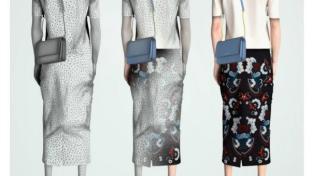Why Tim Gunn "Felt Like Rip Van Winkle"
Though he’s perhaps best known for his role as a mentor on the hit TV show "Project Runway," Tim Gunn has been especially instrumental in moving fashion forward — from the technology side of things.
Gunn said he was “vilified” by the fashion industry when he dared to update the 50-year-old curriculum at the Parsons School of Design, where he moved up from associate dean to eventually chair the fashion design department. When he arrived at the school, students were still hand-sewing every single garment — despite being surrounded by sewing machines. That backwards thinking (“it’s good discipline”) clashed with Gunn’s sensibilities. “Let them hand-sew one seam and then move to the machines,” he told a room full of industry professionals at Gerber Technology’s annual ideation conference in Los Angeles. “Shaking up that curriculum was more than putting new content in place. It was about changing the culture. The pedagogy was so ingrained in the whole structure of the department that [culture] had to be a partner in the change.”
“It’s not cancer research; it’s a sleeve!”
Gerber was the first apparel technology company Parsons reached out to when Gunn inherited the fashion design department in 2000 and sought to bring the institution into the 21st century with computers and software. But incorporating new tech was just the tip of the iceberg. At one point, a number of professors got into a “vociferous debate about the dolman sleeve, of all things,” said Gunn. “Each had beliefs about what makes a dolman sleeve. I thought, ‘this is preposterous. It’s not cancer research; it’s a sleeve!’”
Even when presented with the textbook definition from the Fairchild Dictionary of Fashion, the educators insisted that the book’s version was wrong. And so Gunn put his foot down. “We’re going to have to agree to disagree,” he explained. “We’re taking students and passing them to a successive level where faculty will have expectations [about their knowledge base].”
That’s just one example of the trials and tribulations that go along with change management, he observed. In order for change to truly take hold, everyone involved needs to be a collaborator and partner, and feel as invested in the new strategy as the decision makers. “If it all comes from the top down, it doesn’t work,” he said.
“I felt like Rip Van Winkle”
As someone who was born in “the world of the abacus,” Gunn is impressed by how far apparel technology such as cutters has evolved. “I felt like Rip Van Winkle, seeing what Gerber has been doing with pattern making and the cutting of textiles,” he said. “I came [to ideation] making the assumption that the textiles Gerber is using are all nonwovens because you don’t have to worry about a warp and a weft, and you can use it like cookie dough and just cut it all out. I still can’t quite wrap my brain around all of it. But I’m eager to know where [technology] is going to take us.”
During his time in the private sector as chief creative officer for Liz Claiborne, Gunn said opportunities to interact with customers during fashion presentation roadshows offered invaluable insights into how consumers respond to product and think about a brand’s values. “I learned very quickly that the customer doesn’t really share a lot of the beliefs we have about sustainability and environmental responsibility because she has the perception that it will be more expensive. And we know that the bottom line is the all-important factor here.
“When I see a dress for $16, I think, ‘who’s being pilloried for this?’” Gunn continued. “The more we can do to educate people about how important these values are, the better off we will be. We need to join forces and voices.”
“Left in the dust”
Gunn pointed to domestic manufacturing as a movement that’s “critically important,” with places such as Fall River, Mass., “starting to percolate again.” Sewing automation will be a huge driver in resuscitating American manufacturing, and Gunn theorized that designers will have no choice but to embrace automation. “There are things happening that, if we turn our backs on it, we’ll be left in the dust,” he said.
And for emerging designers who operate at a small scale, stateside automated production could be a “savior.” “This is what will allow them to produce garments without a prohibitively expensive price point,” said Gunn. “Otherwise, they’ll be sewing on their own in their studios, which limits their reach.”
“Cry me a river”
Gunn has a wealth of experience taking risks and making unpopular decisions. “If you don’t have anxiety and a little bit of fear running up your spine, it’s probably not a risk worth taking,” he explained.
Among those risks? Bringing PETA representatives to speak to his students back in the day at Parsons. “There was a huge amount of controversy,” given the school’s long-standing relationships with Scandinavia’s Saga Furs and other purveyors of animal skins, he said. Though he’s anti-fur (but not crazy: “there are people who think we shouldn’t use silk because the poor silkworms. Well, cry me a river”), Gunn said he was more interested in bringing in an opposing point of view for students to consider.
“It was a moment of enlightening,” he explained. The presentation by PETA, not known to sugarcoat the facts, upset many students but Gunn made it clear that while he would never dictate what budding designers could and couldn’t do, they were the ones who would have to accept responsibility for whatever decision they made — and make that decision from an informed perspective. “It really changed things in the department, not just using fur versus not, but [thinking about] dyes, wool. For most of the students, it was a profound turning point in our perception of the world and the role that we have in it.”
“This sounds like a big huge bomb”
Even accepting the role with Project Runway that catapulted him to household-name status was a gamble. “I thought, ‘this sounds like a big huge bomb,’” Gunn said. “Initially, it actually was. We almost didn’t air a full season. And look at us now in season 16.”
Long an advocate for diversity in fashion, Gunn is proud that the show finally took the step of including models of different sizes — ranging from 2 to 22 — in the current season, which concluded on Nov. 16. “Who the industry tells us we need to be ... is completely unrealistic. It’s just something most will not achieve, period,” he said of fashion’s obsession with tall and thin as a largely unattainable standard of beauty. Gunn pointed to the Lifetime TV network as the main obstacle to casting diverse models. “We have something that’s not broken, so why fix it?” he said of the network’s business-as-usual thinking. “I said, ‘if we can’t take a risk with season 16, what can we take a risk with?’ In fact, our ratings are up 15 percent. That says a lot about how the audience is reacting.”
But how did the designers initially react? Shock, mostly. However, Gunn said he stressed how having hands-on experience designing for people of all sizes would boost their careers. Given that the 85 million American women larger than a size 12 are largely neglected by the fashion industry, the show’s young designers — now armed with this crucial experience — will be more viable, more skilled and more in demand when they’re developing their businesses after filming concludes.
Just look at the show’s “real women” episode this season as proof of why diverse model casting is so significant, Gunn noted. Historically, the clothing produced during such challenges has been “simply abhorrent” because the designers are used to working with standard models instead of the regular bodies of 99.99 percent of the population, he explained. “This season [the real women challenge] was among the best work we had because the designers were agile and flexible, as they’d been working with models of all different sizes all season. So it demonstrated in a short period of time how important the experience was.”
Given how successful this new group of models has been, Gunn said the show is “completely married” to maintaining this diversity — and would like to bring these models back as regulars to add more continuity for viewers.
And the show might have other changes in store. “We’re thinking very seriously about bringing computer technology into the workroom so that the designers are working hard and working smart,” he said.




